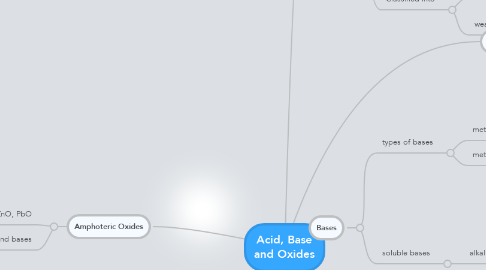
1. Amphoteric Oxides
1.1. Eg., Al2O3, ZnO, PbO
1.2. reacts with both acids and bases
2. Oxides
2.1. Acidic oxides
2.1.1. Eg., SO2
2.1.2. Reacts with bases to form salt and water
2.2. Basic Oxides
2.2.1. Eg., Fe2O3
2.2.2. reacts with acids to form salt and water
2.3. Neutral Oxides
2.3.1. eg., CO, H2O
2.3.2. Does not react with acid and bases
3. partial ionisation to form H+
4. Acid
4.1. Definition
4.1.1. produces H+ in aq solution
4.1.1.1. affects the pH scale
4.1.1.1.1. higher the concentration of H+, lower is the pH
4.1.1.1.2. lower the concentration of H+, the higher the pH value.
4.2. physical properties
4.2.1. sour taste
4.2.2. dissolve in water to form solution to that conducts electricity
4.2.3. turns blue litmus paper red
4.3. chemical properties
4.3.1. reacts with reactive metals to form salt and hydrogen
4.3.2. reacts with carbonates to form salt, water and carbon dioxide
4.3.3. reacts with bases to form salt and water
4.3.3.1. Neutralisation
4.3.3.1.1. H+(aq) + OH- --> H2O(l)
4.4. Classified into
4.4.1. strong acid
4.4.1.1. complete ionisation to form H+
4.4.1.2. Eg., sulfuric acid
4.4.2. weak acid
4.4.2.1. Eg., ethanoic acid
5. Bases
5.1. types of bases
5.1.1. metal oxides
5.1.2. metal hydroxides
5.2. soluble bases
5.2.1. alkalis
5.2.1.1. reactions
5.2.1.1.1. reacts with acid to form salt and water
5.2.1.1.2. gives off ammonia gas when heated with ammonium salt.
5.2.1.2. physical properties
5.2.1.2.1. turns red litmus blue
5.2.1.2.2. bitter taste and soapy feel
5.2.1.3. definition
5.2.1.3.1. produces OH- in aq solution
